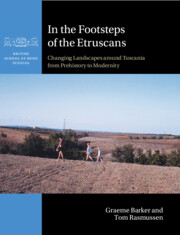Book contents
- In the Footsteps of the Etruscans
- British School at Rome Studies
- In the Footsteps of the Etruscans
- Copyright page
- Dedication
- Contents
- Figures
- Tables
- Contributors
- Preface and Acknowledgements
- 1 The Tuscania Archaeological Survey: Rationale, Aims and Objectives
- 2 Methodologies
- 3 The Natural Landscape and Its Evolution
- 4 Prehistoric Landscapes
- 5 Etruscan Urbanization, c. 700–300 bc
- 6 ‘Romanization’: The Roman Republican Period, c. 300–30 bc
- 7 The Roman Imperial and Late Antique Periods, c. 30 bc–c. ad 700
- 8 Incastellamento and Its Aftermath: Medieval and Modern Landscapes, c. ad 700 to the Present
- 9 A Mediterranean Landscape from Prehistory to Modernity
- Book part
- Bibliography
- Index
6 - ‘Romanization’: The Roman Republican Period, c. 300–30 bc
Published online by Cambridge University Press: 12 October 2023
- In the Footsteps of the Etruscans
- British School at Rome Studies
- In the Footsteps of the Etruscans
- Copyright page
- Dedication
- Contents
- Figures
- Tables
- Contributors
- Preface and Acknowledgements
- 1 The Tuscania Archaeological Survey: Rationale, Aims and Objectives
- 2 Methodologies
- 3 The Natural Landscape and Its Evolution
- 4 Prehistoric Landscapes
- 5 Etruscan Urbanization, c. 700–300 bc
- 6 ‘Romanization’: The Roman Republican Period, c. 300–30 bc
- 7 The Roman Imperial and Late Antique Periods, c. 30 bc–c. ad 700
- 8 Incastellamento and Its Aftermath: Medieval and Modern Landscapes, c. ad 700 to the Present
- 9 A Mediterranean Landscape from Prehistory to Modernity
- Book part
- Bibliography
- Index
Summary
The survey indicates marked continuity in rural settlement around Tuscania from Etruscan times into Roman Early Republican period (c.300-170 BC: 212 sites), implying that there was minimal disruption to pre-existing systems of ownership following the subjugation of the area by the Roman army. There was a dramatic expansion in rural settlement, a filling-up of the countryside particularly in formerly under-developed areas away from the town. This growth was encouraged by a better communications network, especially by the upgrading of the Via Clodia.There were increased levels of investment both in the town and in the surrounding countryside. Maximum site numbers developed in the Later Republican period (170-30 BC: 230 sites), and on the evidence of intensive grid collection of surface remains at selected sites, and geophysical survey at others, the core buildings of agrarian units first reached their maximum extent at this time. However, there is little evidence for large slave-run villas producing goods geared primarily for export and displacing the free peasantry, despite the written sources emphasizing this process throughout Italy at this time: the countryside around Tuscania was dominated by small farms and villages, and high-ranking sites did not bring significant changes to long-established farming regimes.
Keywords
- Type
- Chapter
- Information
- In the Footsteps of the EtruscansChanging Landscapes around Tuscania from Prehistory to Modernity, pp. 176 - 213Publisher: Cambridge University PressPrint publication year: 2023



